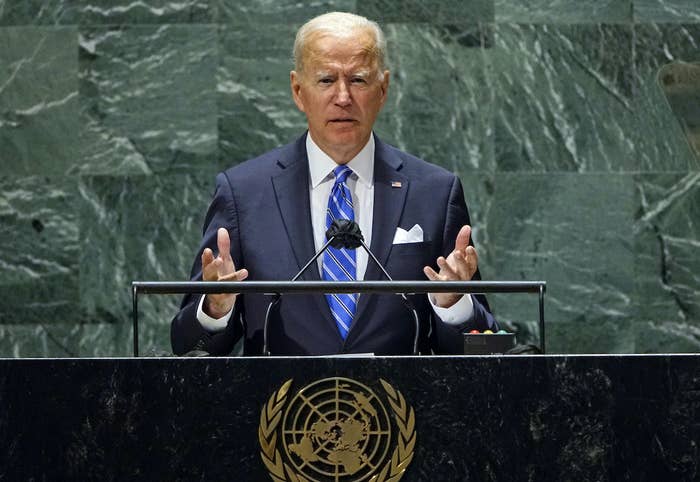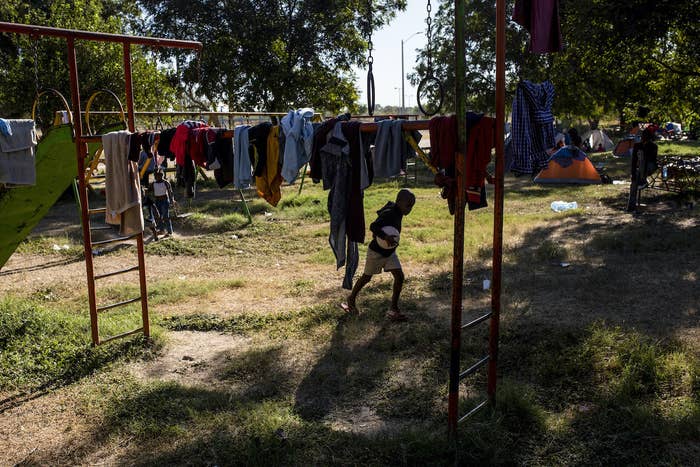
Unlike his predecessor, President Joe Biden doesn’t obsess publicly over the southern border and the immigrants seeking to cross it. But on rare occasions, he is blunt about what he wants to happen there.
During a press conference in March, his first as president, Biden took a position that was not too far from that of former president Donald Trump’s: Immigrant families arriving at the border need to be turned back. This was not the time to come to America, officials had repeated over and over this spring.
“They should all be going back, all be going back,” Biden said. “The only people we're not going to [let sit] there on the other side of the Rio Grande by themselves with no help are children.”
As the US now conducts mass deportations of Haitians arriving at the border, the Biden administration has not yet resolved the tension inherent in that early remark, which surprised and confounded some within the Department of Homeland Security and outraged many immigrant advocates.
The question remains: What exactly is the country’s direction on immigration policy under Biden?
The Biden administration has undone several initiatives enacted under Trump, notably the entry ban for people from several majority-Muslim nations. It has also pursued aspects of the progressive agenda it promised by limiting arrests by deportation officers, largely ceasing detention of families, and reuniting many parents and children separated by the Trump administration.
Less heralded efforts, like expanding work permits for immigrant crime victims and broadening the legal methods by which Central American children may reunite with parents in the US, have also taken off after several months. Moreover, the administration has in recent weeks backed a congressional effort to create a pathway to citizenship for millions of immigrants living in the US.
But when faced with issues at the border — such as an increased flow of families and single adults beginning this spring or the recent crowd of thousands of Haitians under a bridge in Del Rio, Texas — Biden has turned to an approach favored by many leaders before him, including Trump: deterrence.

The administration has relied on a Trump-era order to conduct more than 700,000 expulsions since February that have severed immigrants from asylum protections, successfully convinced Mexico to ramp up enforcement within its own borders, and restarted another enforcement program to conduct quick deportations of families at the border.
Meanwhile, by continuing to expel people under the Title 42 policy, which cites the pandemic as the reason for allowing border agents to quickly turn back asylum-seekers, the administration was able to more efficiently clear the camp of thousands of Haitians in Del Rio. In a matter of days, the US removed, mainly through Title 42, more than 1,400 Haitians to Haiti.
However, advocates have successfully argued in court that the measure violates US laws that provide guaranteed access to the asylum system. And United Nations officials have raised concerns that the administration is violating international norms.
“These mass deportations to Haiti are unconscionable, but also creating a human rights crisis for this population,” said Nicole Phillips, an adjunct professor at the University of California, Hastings College of the Law, and legal director of the Haitian Bridge Alliance. UNICEF has estimated that over 2 in 3 immigrants sent back to the capital of Haiti have been women and children.
BuzzFeed News spoke with 20 government officials — some Biden appointees, others career staffers at DHS and the Department of Justice who focus on immigration — to understand how the policies that arose in January are being implemented and understood internally. They spoke with BuzzFeed News on the condition of anonymity due to the fact that they were not authorized to speak publicly.
To some, the first seven months of Biden’s administration have yielded a disjointed approach that pushes some progressive policies while favoring others that restrict immigration, especially at the border. This approach, the officials added, reflects a lack of consensus and an apparent effort to prevent Republicans from inflicting maximum political damage while avoiding alienating some voters.
“There is a complete lack of direction,” said one administration official. “Everything is deferred to the White House National Security Council, which can't see past low polls on immigration and are terrified their own shadow may be a pull factor. Career and political staff are equally concerned.”
Another administration official echoed those remarks. “I don’t know what our immigration strategy is at all,” the official said. “I don’t know if we are building an infrastructure for the future, or what direction we will be going in as we head into a midterm election year.”
Career DHS officials have increasingly started to notice similar inconsistencies.
“We are slowly making progress on policies for creating a more humane immigration system while maintaining some of the most inhumane policies for asylum-seekers,” one official said. “You can reverse all of the terrible court cases… but as long as Title 42 remains in place, none of that matters. We are turning our backs on the most vulnerable.”
Other officials were more blunt.
“They are almost exclusively focused on detention, deterrence, and generally treating asylum-seekers with as much violence and inhumanity as the prior administration,” this official said. “Honestly, I don’t know how much longer I can stay at DHS if this continues. I stayed because I believed Joe Biden and Kamala Harris when they promised to build it back better. The despair I am feeling about what they are doing now is indescribable. I can’t go on like this.”
Officials throughout Trump’s administration were clear on where the president stood on the issue: He wanted to, in nearly every way, stop immigrants from entering the US. Senior adviser Stephen Miller made sure that happened through policymaking and obsessive focus on the issue. And appointments of Trump allies led to a dizzying array of changes on immigration at DHS.
Such direction and clarity do not exist under the Biden administration, according to officials who spoke with BuzzFeed News. While Biden has been vocal on the administration’s efforts in Congress and to protect immigrants known as Dreamers, he has largely eschewed discussing other issues, like access to asylum at the border or how ICE should operate.
A spokesperson for DHS said the administration has been clear since Day One that officials are undertaking "a monumental task to rebuild our previously decimated immigration system while enforcing our laws."
"We have worked swiftly to do so and progress has been made," the spokesperson added. "As we have said repeatedly, it will take time, and it will not be easy. We not only respect differences of opinion; we encourage them as a hallmark of good ideas and good government."
In the meantime, policymaking has been doled out by appointees who, at times, have vastly different perspectives on what needs to happen. Due to the leadership vacuum, some say, administration officials are left to battle it out among those who favor a tougher approach and those who do not, leading to a mixed bag of policies.
There are those within Biden’s administration who believe that a tougher approach at the border is necessary in order to curb the flows of immigrants and incentivize legal pathways to the US. These perspectives echo the deterrent approach favored during the Obama administration. While Trump faced criticism for his border policies, it was Obama who also saw detention as a way to stop families from crossing the border and opened up the nation’s largest family detention center in Texas in 2014.
“It will now be more likely that you will be apprehended, it will now be more likely that you will be detained and sent back,” said then–DHS secretary Jeh Johnson to reporters that year, according to Reuters.
There are others, however, who believe that the focus on deterrence, through Title 42 and other initiatives, will continue to yield the same results.
“This administration’s immigration policy is schizophrenic,” said one senior DHS official. “Their words are not backed up by policy choices or deeds. The border would be challenging under any circumstances, but this administration is stuck in a deterrence-only posture, expecting different results from similar approaches. Flows are going to continue. It would be better for the administration to focus on how to process them in a faster and more humane manner instead of focusing on how to convince desperate people not to make the journey.”
Still, some officials were more forgiving of the White House, which has been working to undo Trump-era policies during a pandemic amid rising numbers of immigrants arriving at the border.
“This is a very different set of challenges at the border from the 2019 surge,” one DHS official said. “This is essentially that, but throw in the significant COVID complications.”
The practical impact for those on the ground is that seeking asylum at the US border continues to be challenging.
One of those asylum-seekers initially turned around by the Biden administration was Veronica, a Honduran woman who left her home country in 2019 and attempted to enter the US in August. The 38-year-old, who arrived at the border with her 2-year-old daughter and her husband, fled Honduras in search of safety and better medical access. She has a prosthetic left foot. When she arrived at the US border, officials processed her and then sent her to Mexico under Title 42.
She cried, thinking of everything she had gone through to make it to the US border.
“I just prayed and thought God was going to find a way to help me,” she said through an interpreter.
In Mexico, she went to a local shelter and called a phone number for an organization, Las Americas Immigrant Advocacy Center, that could help her. Ultimately, attorneys there were able to persuade US officials to allow her back in several weeks later.
“To say the family would have been stuck between a rock and a hard place is sugarcoating the dilemma they faced had they not been exempted from Title 42,” said Nicolas Palazzo, an attorney with Las Americas. “The administration's indefinite use of Title 42 forces onto them a false choice between two versions of a hellish life — either return to their country or remain in Mexico. In both instances, they face persecution, discrimination, and no access to appropriate healthcare for her medical condition. The cruel irony of a public health order putting their and thousands of others' lives directly in harm’s way cannot be ignored.”
